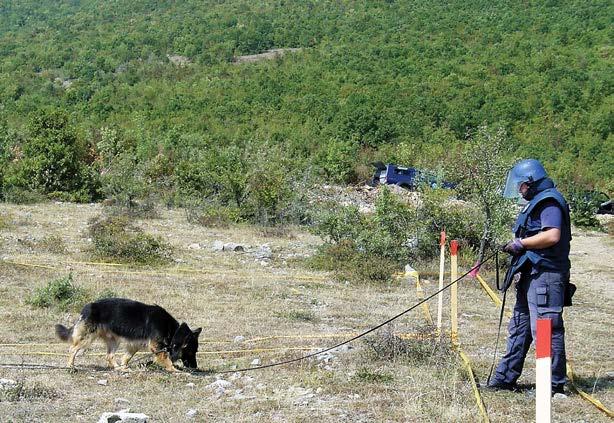
2 minute read
Humanity's Best Friend Detects Landmines and Explosive Remnants of War
Service dogs are renowned for excelling at tasks. Some serve as seeing eye dogs. Others sniff for illicit drugs. Some are trained to provide emotional support. But the use of trained mine detecting dogs (MDD) to locate landmines and ERW is less known. Our most faithful companion’s role in sniffing out these threats deserves equal attention.
“Since World War I, trained war dogs have carried messages across battlefields, guided medics to wounded soldiers, and located hidden tunnels,” explains Perry F. Baltimore III, Executive Director of the Marshall Legacy Institute (MLI), a U.S. NGO that enlists public support to donate MDDs for use in post-conflict demining and ERW clearance. “In the past two decades or so, methodologies to train dogs to sniff out the explosive odors found in landmines has also led to the use of MDDs—canine heroes who have a critical role in humanitarian demining. Their part in saving lives and helping restore wartorn land to productive use is beyond measure.”
Advertisement
Each MDD is paired with a trained human handler who maintains constant visual contact and leash control as the dog searches for mines or ERW. The MDD’s focus and calm reaction to suspected devices is extremely important, and results from training that begins after it is 12 months old. When the MDD’s sensitive nose detects the scent of explosives or other chemicals leaking from a landmine or ERW, it immediately stops and sits before the suspect object. That signals the deminer, who uses a metal detector or other means to verify if a mine or ERW has been located.
Due to their intelligence, physique, and temperament, Belgian Malinois are the breed used most often as MDDs. Generally, their professional life span averages from six to eight years.
“Belgian Malinois are the service dogs we normally select and train for humanitarian demining and other specialized tasks too,” comments Nermin Hadžimujagić, Director of the Mine Detection Dog Center (MDDC), an NGO located in Bosnia and Herzegovina. “There are occasions where extreme climate or harsh terrain rule out the use of any breed of MDDs. But MDDs can operate in most places human deminers work, and help safely speed the rate at which landmines and ERW are found.”
“It can be difficult for handlers to maintain non-stop visual contact with MDDs especially in undergrowth, jungles, and urban environments,” observes Per Håkon Breivik, NPA’s Director of Humanitarian Disarmament. “Such is the case in Iraq, Lebanon, and Cambodia, for instance, where NPA’s landmine and BAC programs are funded by PM/WRA. To overcome those obstacles, NPA is conducting tests with GPS and small video cameras mounted to an MDD so the handler can monitor the dog’s movements and signals even when it’s temporarily out of sight. Our tests are promising and may result in less time expended on clearing access lanes and more effort devoted to actual detection and clearance.”
Retired MDDs are often adopted by their handlers, with whom they have a special bond. If the handler is unable to adopt the MDD, others willing to offer a safe, loving home with proper care can also provide a pleasant retirement.
The next time you observe a seeing eye dog at work or have your luggage sniffed by a customs enforcement dog at an airport, remember that these service animals have counterparts who are seeking landmines on former battlefields. They are the dogs of peace.
An MDD and handler work together in Kosovo. Photo courtesy of MDDC.










